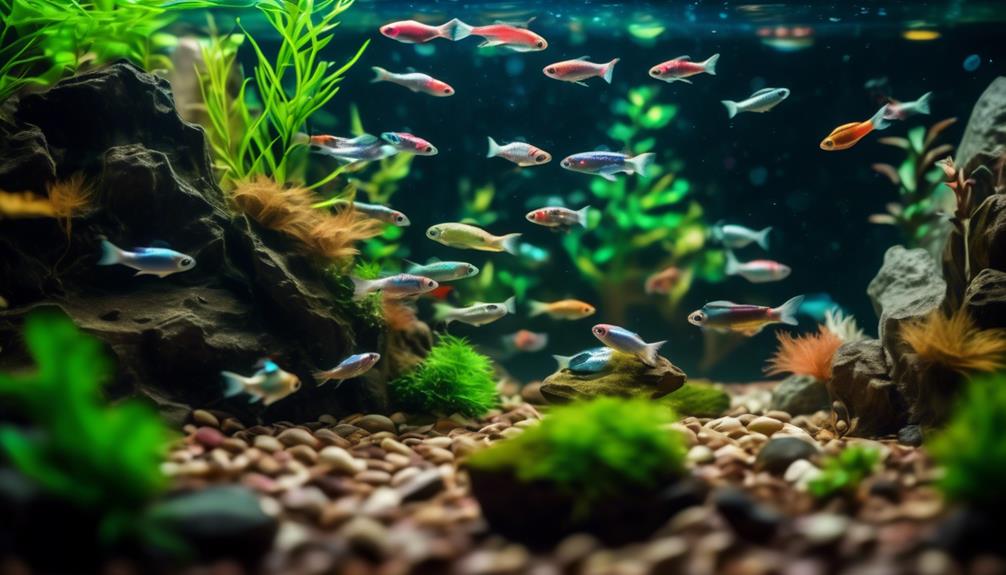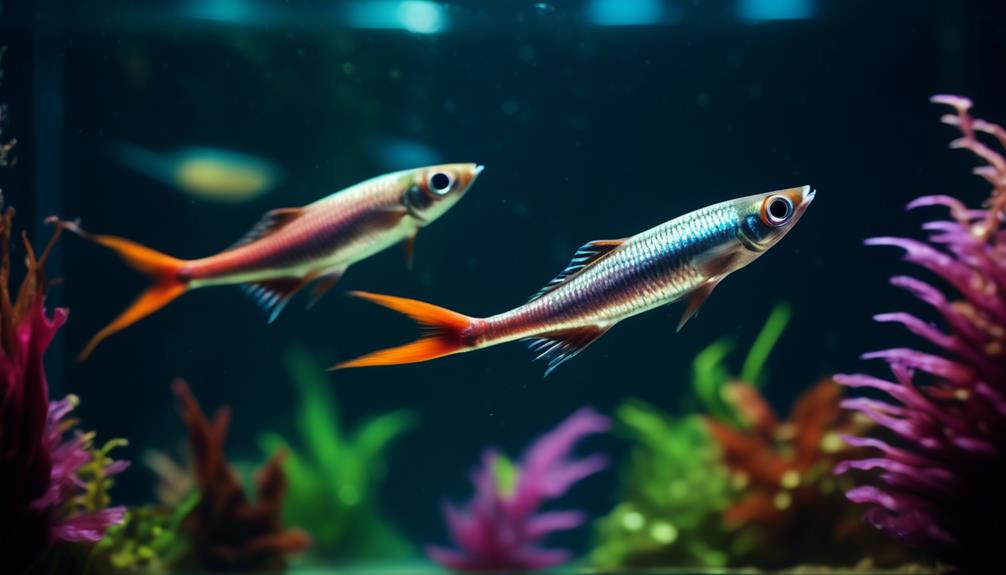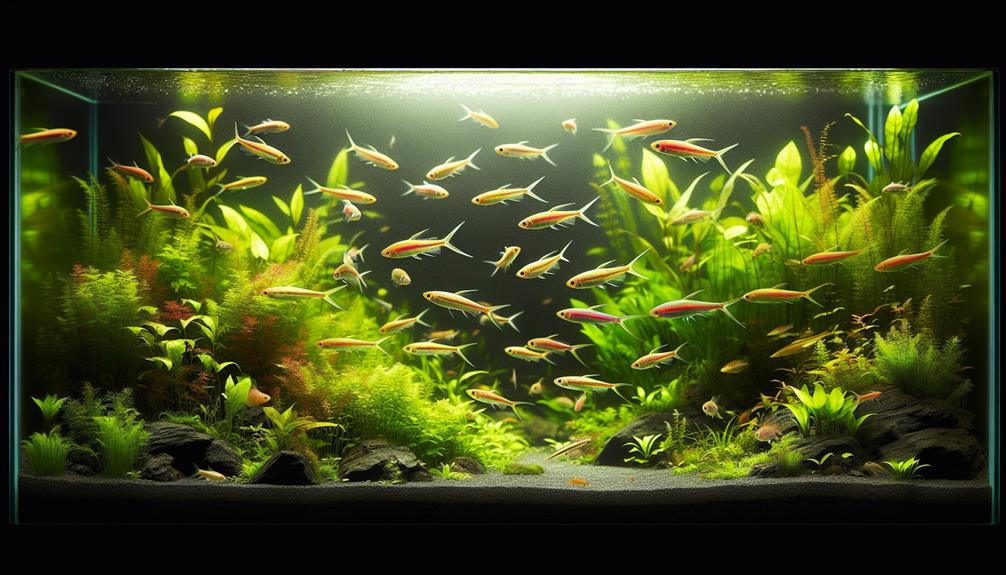Welcome to the world of pencilfish, where elegance and beauty meet in the aquatic realm. Within this article, we will embark on a journey to uncover the secrets of caring for and breeding these fascinating creatures.
From understanding the diverse species to creating the perfect habitat and ensuring their nutritional needs are met, we will explore every aspect of pencilfish care.
But that's not all; we will also delve into the art of breeding these delicate fish, unraveling the mysteries of their mating behaviors and providing insights into successful reproduction.
So, prepare to be captivated by the wonders of pencilfish and join us as we unravel the ultimate guide to their care and breeding.
Key Takeaways
- Pencilfish species include hockeystick, diptail, brown, Beckfords, coral red, purple, and dwarf pencilfish.
- A 20-gallon high or 29-gallon tank is suitable for pencilfish, with tropical temperatures and pH levels between 75-80°F (24-27°C) and 6.5-7.5 respectively.
- Catappa leaves can be added to the water to gently acidify it if needed, and a tight-fitting lid is important to prevent jumping.
- Pencilfish can be paired with tank mates such as corydoras, tetras, rasboras, and dwarf cichlids, but should be kept separate from aggressive betta fish and cherry and crystal shrimp. They can also act as dither fish to help shy species feel more comfortable.
Pencilfish Species

Pencilfish, a group of small tropical fish, encompass several species including the Hockeystick, Beckfords, Coral red, Purple, and Dwarf pencilfish. Each species offers unique characteristics and challenges when it comes to breeding and maintaining their color variations and patterns.
Breeding challenges vary among the different pencilfish species. While some, like the Beckfords pencilfish, are relatively easy to breed, others may require specific conditions. For successful breeding, a separate breeding tank with softer pH and warmer temperature is recommended. Providing hiding places such as java moss, dense foliage, spawning mops, or marble substrate can encourage egg laying. Additionally, feeding the parents well helps stimulate their spawning behavior.
Color variations and patterns are a notable feature of pencilfish species. The Hockeystick pencilfish, for example, displays a distinct brown coloration, while the Beckfords pencilfish comes in golden and red variations. The Coral red pencilfish showcases a vibrant red arc on its body, while the Purple pencilfish exhibits a beautiful purple hue. The Dwarf pencilfish, as its name suggests, is smaller in size and displays subtle color variations.
Understanding the breeding challenges and appreciating the color variations and patterns of each pencilfish species is essential for aquarists who desire serving others by providing a diverse and visually appealing aquarium experience.
Setting Up the Aquarium
To ensure the optimal care and breeding conditions for pencilfish, it is crucial to set up the aquarium with careful consideration of various factors.
Choosing the right tank size is important, and a 20-gallon high or 29-gallon tank is recommended for pencilfish.
Filtration is essential to maintain water quality, and a filter with a low flow rate is ideal for these delicate fish.
Adequate lighting is also necessary to support the growth of live plants and create a natural environment.
Additionally, it is important to create a comfortable habitat for pencilfish by incorporating live plants and tall decorations to provide hiding places and minimize territorial disputes.
A tightly-fitting aquarium lid should be used to prevent these active jumpers from escaping.
Compatible Tank Mates

When considering tank mates for pencilfish, it is important to choose species that are compatible and will create a harmonious environment within the aquarium. Here are some guidelines to help you select the right companions for your pencilfish:
- Corydoras, tetras, and rasboras make good tank mates for pencilfish due to their similar water requirements and peaceful nature.
- Pairing pencilfish with dwarf cichlids like apistogrammas can create a visually appealing and diverse community tank.
- It is crucial to separate pencilfish from aggressive tank mates, such as betta fish, to prevent any harm or stress to the pencilfish.
- Avoid keeping pencilfish with cherry and crystal shrimp, as they can become a potential food source for the pencilfish.
- Pencilfish can also act as dither fish, helping shy species feel more comfortable and encouraging them to come out of hiding.
Pencilfish Diet
Pencilfish have specific dietary requirements that should be met in order to ensure their optimal health and well-being. Providing a balanced diet is crucial for these fish, as it promotes growth, vibrant colors, and overall vitality. When it comes to the best food options for pencilfish, a variety of tiny floating or slow-sinking foods are recommended. This includes baby brine shrimp, cyclops, daphnia, crushed flakes, and Easy Fry and Small Fish Food. To keep the food buoyant, it is important to avoid fast flow near the water surface. Additionally, offering a high-quality diet is essential for the health of pencilfish. Feeding these fish multiple times a day in small portions is ideal to prevent overeating and maintain water quality. Ensuring a varied diet and following a consistent feeding schedule will help pencilfish thrive in the aquarium.
| Pencilfish Diet | Best Food Options |
|---|---|
| Feeding Schedule | Multiple times a day in small portions |
| Importance of Variety | Promotes growth, vibrant colors, and vitality |
| Feeding Tips | Avoid overfeeding and maintain water quality |
Breeding Pencilfish

Breeding pencilfish requires careful preparation and specific conditions in order to successfully encourage spawning behavior. Here are some essential breeding techniques and challenges to consider:
- Separate breeding tank: Set up a separate 10-gallon tank for breeding pencilfish. This tank should have softer pH levels and warmer temperatures to mimic their natural breeding environment.
- Provide hiding spots: Add java moss, dense foliage, spawning mops, or marble substrate to create hiding spots for the eggs. These hiding spots will protect the eggs from being eaten by the parents or other tank mates.
- Proper nutrition: Feed the parent pencilfish a nutritious diet to stimulate spawning behavior. A well-fed parent is more likely to produce healthy eggs and fry.
- Transfer or remove parents: Once the eggs are laid, it is crucial to either transfer them to a separate container or remove the parents from the breeding tank. This prevents the parents from eating the eggs or fry.
- Challenges: Breeding pencilfish can be challenging due to their specific requirements and sensitivity to water conditions. Maintaining stable water parameters, providing the right diet, and ensuring a suitable breeding environment are crucial for successful breeding.
Frequently Asked Questions
How Long Do Pencilfish Typically Live?
The lifespan of pencilfish varies depending on factors such as species, diet, water quality, and overall care. On average, pencilfish can live for 3-5 years, but with proper care and a suitable environment, their lifespan can be extended.
Can Pencilfish Be Kept in a Community Tank With Other Fish Species?
Pencilfish can be kept in a community tank with compatible fish species such as Corydoras, tetras, and rasboras. Pencilfish have peaceful behavior and temperament, making them suitable tank mates for a variety of fish.
Do Pencilfish Require a Specific Type of Substrate in Their Aquarium?
When setting up an aquarium for pencilfish, it is important to choose the right substrate. Avoid using sharp or abrasive substrates that could damage their delicate bodies. Opt for fine-grained sand or smooth gravel to create a natural environment.
How Often Should Pencilfish Be Fed?
Pencilfish should be fed small, floating or slow-sinking foods multiple times a day to meet their dietary needs. The feeding frequency depends on the individual fish, but a general guideline is to feed them 2-3 times daily. The typical lifespan of pencilfish ranges from 3-5 years.
Are Pencilfish Prone to Any Specific Diseases or Health Issues?
Pencilfish are generally hardy and not prone to specific diseases. However, they can be susceptible to common aquarium ailments such as ich and fin rot. Regular water changes, proper nutrition, and a stress-free environment can help prevent diseases in pencilfish.
Conclusion
In conclusion, mastering the art of caring for and breeding pencilfish requires careful attention to their specific needs.
By understanding their unique characteristics, setting up an ideal aquarium environment, selecting compatible tank mates, providing a balanced diet, and implementing successful breeding practices, enthusiasts can ensure the health and wellbeing of these slender and elegant creatures.
So dive into the world of pencilfish and unlock the secrets to their care and breeding success.

